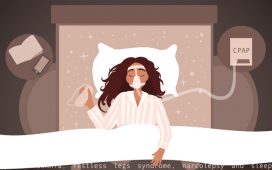Income and safety and health…OH MY! They’re the leading stress builders from sea to shining sea. And let’s not forget politics. No matter which side of the aisle you’re on, this topic stresses so many Americans.
According to a national poll, conducted by the American Psychiatric Association (APA) (1), Americans’ anxiety levels experienced sharp increases in 2018. FYI: APA’s 2018 U.S. anxiety score – derived by mean scores on a 0 to 100 scale – is 51. That’s a five-point jump since 2017. And no demographic is exempt, with millennials continuing to be more anxious than Gen Xers or baby boomers, although baby boomers’ anxiety level increased the most, with a seven-point jump between 2017 and 2018.(1)
In addition to mental health professionals, it’s likely that healthcare providers (HCP) are also affected by this influx in anxiety – since this “feeling” often goes hand in hand with physical symptoms that steer patients to their HCP.
Let’s look at January 2019 for instance. Seventy-four percent of U.S. primary care physicians (PCPs) report that their patient population was physically affected by the infamous government shutdown.(2)
So before reaching for the prescription pad, let’s review a few of those stress-induced physical symptoms that mimic symptoms associated with other health problems.
- Insomnia
- Headaches
- Digestive Issues, including nausea, diarrhea, and/or constipation
- Chest pain, sometimes accompanied by shortness of breath
- Jaw issues, such as clenched jaw, pain, and/or teeth grinding
- Fatigue and/or low energy
- Frequent sickness and colds
- High blood pressure
- Acne
The American Institute of Stress(3) (AIS) offers a lengthy explanation of why and how stress induces physical symptoms and reprocutions, but here’s just one that might steer a patient to their PCP. As AIS explains on its website, frequent or chronic stress forces the heart to work too hard for too long and also raises the patient’s blood pressure. As this happens, AIS adds, “so do your risks for having a stroke or heart attack.”(3)
In fact, there’s a stat released as part of a 2013 study that remains relevant and widely quoted today: 60 to 80 percent of primary care visits involve a stress component. (4)
So what do you think about stress in America? Are more over-stressed, anxious patients showing up in your waiting room with physical symptoms?
RESOURCES
- Americans Say They are More Anxious than a Year Ago; Baby Boomers Report Greatest Increase in Anxiety: https://www.psychiatry.org/newsroom/news-releases/americans-say-they-are-more-anxious-than-a-year-ago-baby-boomers-report-greatest-increase-in-anxiety
- Sick Over the Government Shutdown? 74% of Primary Care Physicians Report their Patients Are Affected by It, According to Data from InCrowd. https://incrowdnow.com/press-release/sick-over-the-government-shutdown-74-of-primary-care-physicians-report-their-patients-are-affected-by-it/
- Stress Effects: https://www.stress.org/stress-effects/
- When Physicians Counsel About Stress: Results of a National Study: https://www.ncbi.nlm.nih.gov/pmc/articles/PMC4286362/







